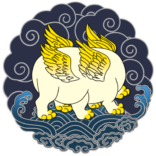
Non-invasive Needling Technique
Needling the body at specific locations is a therapeutic method first recorded in the ancient medical classic on needle therapy, Yellow Emperor’s Inner Canon, Volume II, Ling Shu Chapter I, The Nine Needles and the Twelve Origins 《黃帝内經·靈樞·九鍼十二原》. It is considered the most gentle, non-invasive yet highly effective modality among all holistic therapies.
It is translated into “acupuncture” because the most practiced form requires the needles piercing through the skin. However, in ancient times when needles were not as thin and sharp as the modern ones, physicians did not necessarily break through the skin surface to achieve effective results. The Japanese have researched and developed the non-invasive style of needles and corresponding non-insertive needling techniques based on the ancient medical texts. These needles are named based on their functions, and they are used for specific conditions. The needle with a round, millet-shaped tip is called Teishin, the most common type of needle used to regulate Qi, or vital life force of the body. The fan-shaped needle, Yoneyama, is used to expel pathogenic energies. The thicker rod-shaped needle, En-shin, is a tool for separating stagnant or stuck energies.
These needles are applied with different techniques to deliver different treatment results. Sometimes a practitioner may apply many styles of techniques to achieve the desired effects. In addition, Different materials also affect the functions of the needles.
Conductive metals such as pure silver, gold, and copper are considered the best material to make these needles. While all suitable for any patient, they are used for specific conditions. Silver is the most widely applicable metal because it is well-balanced, powerful yet gentle; copper is mostly used for young folks, since their energies tend to be active and fast-changing; gold is more used for extremely depleted individuals or people of old age.
The Needle Makers
Due to their irregular shapes, these non-invasive needles can only be handmade. Some are made by Japanese masters, some are made by Navajo silversmiths, while some are made by Oregon local artists. Each needle has a unique origin and story. And each of them carries special healing powers. You do not need to believe in such intangible concepts, the treatment results are self-explanatory.
Gentle techniques do not mean they are less effective than strong stimulations. In fact, they are surprisingly powerful and effective. It is proven in the clinic that our body responds well to non-invasive needling. It does not need to hurt to make you feel better.
Japanese Rice Grain Moxa
The highest-grade golden moxa in the world can only be found in a small factory in Niigata, Japan. Every winter, the workers manually process harvested and dried mugwort plant in the cold weather, without heating facilities, removing roots, stems, and leaves, only preserving the fine golden fur on the leaves. Only a small quantity of the top-grade moxa can be produced each year. Such moxa is so precious not only because it is extremely rare and hard to produce, but also because of its incredible therapeutic quality.
During a treatment, an herbal salve called Shiunko is first dabbed on the skin, then a half-rice-grain sized cone of golden moxa is placed on the salve and lit at the tip with an incense stick, then it is quickly put out before the skin feels a pinch of heat (warm but not too hot). In many cases, this is already enough to bring significant results. This process can also be repeated 2, 4, or 8 more times when needed. Most clients find that the subtle aroma of pure moxa is very calming and soothing. It is safe even for clients with respiratory conditions or are sensitive.
Rice grain moxa is effective in treating many conditions, including but not limited to hormonal imbalance, auto immune disorders, sugar imbalance, psycho-emotional issues, sleep issues, digestive issues, chronic pain, and more.

